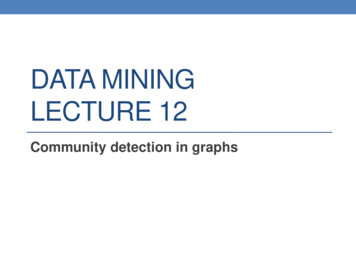
Transcription
DATA MININGLECTURE 12Community detection in graphs
Communities Real-life graphs are not random E.g., in a social network people pick their friends based ontheir common interests and activities We expect that the nodes in a graph will beorganized in communities Groups of vertices which probably share common propertiesand/or play similar roles within the graph How do we find them? Nodes in communities will be densely connected to eachother, and sparsely connected with other communities Sounds familiar?
3NCAA Football networkCan we identifynode groups?(communities,modules, clusters)Nodes: FootballTeamsEdges: Gamesplayed
4NCAA conferencesNodes: FootballTeamsEdges: Gamesplayed
5Protein-Protein interaction networksCan we identifyfunctionalmodules?Nodes: ProteinsEdges: Physicalinteractions
6Functional modulesNodes: ProteinsEdges: Physicalinteractions
7
8Stanford Facebook networkCan we identify socialcommunities?Nodes: FacebookUsersEdges: Friendships
9Social communitiesHigh schoolStanford (Squash)SummerinternshipStanford (Basketball)Nodes: FacebookUsers
Community types Overlapping communities vs non-overlappingcommunities
Non-Overlapping communities Dense connectivity within the community, sparseacross communitiesNodesNodesNetworkAdjacency matrix
Overlapping communities
Community detection as clustering In many ways community detection is justclustering on graphs. We can apply clustering algorithms on theadjacency matrix (e.g., k-means) We can define a distance or similarity measurebetween nodes in the graph and apply otheralgorithms (e.g., hierarchical clustering) Similarity using jaccard similarity on the neighbors sets Distance using shortest paths or random walks. There are also algorithms that are specific tographs
The Girvan-Newman method Hierarchical divisive method Start with the whole graph Find edges whose removal “partitions” the graph Repeat with each subgraph until single verticesWhich edge to remove?
The Girvan-Newman method Select cut-edges (a.k.a. bridge edges): edgesthat when removed they disconnect the graph There may be many of those
The Girvan-Newman method Select cut-edges (a.k.a. bridge edges): edgesthat when removed they disconnect the graph Or, more often, there may be none
The Girvan-Newman method Select cut-edges (a.k.a. bridge edges): edgesthat when removed they disconnect the graph Or, more often, there may be none
Edge importance We need a measure of how important an edge isin keeping the graph connected Edge betweenness: Number of shortest pathsthat pass through the edge
Edge Betweeness Betweeness of edge (𝑎, 𝑏) (𝐵(𝑎, 𝑏)): For each pair of nodes 𝑥, 𝑦 compute the number of shortest pathsthat include (𝑎, 𝑏) There may be multiple shortest paths between 𝑥, 𝑦 (𝑆𝑃(𝑥, 𝑦)).Compute the fraction of those that pass through (𝑎, 𝑏) Assumes a unit of traffic flow between (𝑥, 𝑦)𝐵 𝑎, 𝑏 𝑥,𝑦 𝑉 𝑆𝑃 𝑥, 𝑦 𝑡ℎ𝑎𝑡 𝑖𝑛𝑐𝑙𝑢𝑑𝑒 𝑎, 𝑏 𝑆𝑃 𝑥, 𝑦 Betweenness computes the probability of an edge tooccur on a randomly chosen shortest path between tworandomly chosen nodes.
Examples3x11 331x12 127x7 491BFHDAEGCb 16b 7.5
The Girvan Newman Algorithm Given an undirected unweighted graph: Repeat until no edges are left: Compute the edge betweeness for all edges Remove the edge with the highest betweeness At each step of the algorithm, the connectedcomponents are the communities Gives a hierarchical decomposition of the graphinto communities
22Girvan Newman method: An exampleBetweenness(7, 8) 7x7 49Betweenness(1, 3) 1X12 12Betweenness(3, 7) Betweenness(6, 7) Betweenness(8, 9) Betweenness(8, 12) 3X11 33
23Girvan-Newman: Example1123349Need to re-compute betweenness at every step
24Girvan Newman method: An exampleBetweenness(1, 3) 1X5 5Betweenness(3,7) Betweenness(6,7) Betweenness(8,9) Betweenness(8,12) 3X4 12
25Girvan Newman method: An exampleBetweenness of every edge 1
26Girvan Newman method: An example
27Girvan-Newman: ExampleStep 1:Step 3:Step 2:Hierarchical network decomposition:
28Another example5X5 25
29Another example5X6 305X6 30
30Another example
31Girvan-Newman: Results Zachary’s Karate club:Hierarchical decomposition
32Girvan-Newman: ResultsCommunities in physics collaborations
33How to Compute Betweenness? Want to compute betweenness of pathsstarting from node 𝐴
34Computing Betweenness1. Perform a BFS starting from A2. Determine the number of shortest path from A toeach other node3. Based on these numbers, determine the amountof flow from A to all other nodes that uses eachedge
35Computing Betweenness: step 1Initial networkBFS from A
36Computing Betweenness: step 2 Count how many shortest paths from A to aspecific nodeLevel 1Level 2Top-downLevel 3Level 4
Computing Betweeness: Step 3 Compute betweenness by working up the tree: For every node there is a unit of flow destined for thatnode that it is divided fractionally to the edges thatreach that nodeThere is a unit of flow to K that reaches Kthrough edges (I,K) and (J,K)Since there are 3 paths from I to K and 3from J, each edge gets ½ of the flow:Betweeness ½Bottom-up
Computing Betweeness: Step 3 Compute betweenness by working up the tree: If the node has descendants in the BFS DAG, we alsoneed to take into account the flow that passes from thatnode towards the descendantsFor node I, there is a unit of flow to Ifrom A, but also ½ of flow that passesfrom I towards K (we have computedthat as the betweeness of edge (I,K)):Total flow 3/2There are 2 paths from F to I and 1path from G to I edge (F,I) gets 2/3 ofthe total flow: Betweeness 2/3*3/2 1Edge (G,I) gets 1/3 of the total flow:Betweeness 2/3*3/2 1Bottom-up
Computing Betweeness Repeat the process for all nodes and take thesum
40Example
41Example
42Computing Betweenness Issues Scalability Test for connectivity? Re-compute all paths, or only those affected Parallel computation Sampling
Community detection as clustering In many ways community detection is just clustering on graphs. We can apply clustering algorithms on the adjacency matrix (e.g., k-means) We can define a distance or similarity measure between nodes in the graph and apply other algorithms (e.g., hierarchical clustering)











